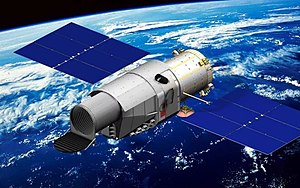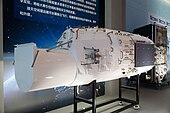 Artist's rendering of Xuntian space telescope | |||||||||||||
| Mission type | Astronomy | ||||||||||||
|---|---|---|---|---|---|---|---|---|---|---|---|---|---|
| Operator | CNSA | ||||||||||||
| Mission duration | 10+ years (planned) | ||||||||||||
| Spacecraft properties | |||||||||||||
| Dry mass | 15,500 kilograms (34,200 lb)[1] | ||||||||||||
| Start of mission | |||||||||||||
| Launch date | 2026[2] (planned) | ||||||||||||
| Rocket | Long March 5B | ||||||||||||
| Launch site | Wenchang Satellite Launch Center | ||||||||||||
| Contractor | CASC | ||||||||||||
| Orbital parameters | |||||||||||||
| Reference system | Low Earth orbit | ||||||||||||
| Main telescope | |||||||||||||
| Diameter | 2 metres (6.6 ft) | ||||||||||||
| Focal length | 28 m (92 ft) | ||||||||||||
| Wavelengths | 255 ~ 1000 nm (Survey camera), 0.41~0.51 THz (590~730 μm) (Terahertz receiver) | ||||||||||||
| Resolution | 0.15 arcsec | ||||||||||||
| |||||||||||||
Xuntian (Chinese: 巡天; pinyin: Xúntiān; lit: Tour of Heaven),[a] also known as the Chinese Space Station Telescope[5] (CSST) (Chinese: 巡天空间望远镜; pinyin: Xúntiān Kōngjiān Wàngyuǎnjìng) is a planned Chinese space telescope currently under development.[6]

It will feature a 2-meter (6.6 foot) diameter primary mirror and is expected to have a field of view 300–350 times larger than the Hubble Space Telescope.[7] This will allow the telescope to image up to 40 percent of the sky using its 2.5 gigapixel camera.

As of 2024, Xuntian is scheduled for launch no earlier than late 2026[2][8][9] on a Long March 5B rocket to co-orbit with the Tiangong space station in slightly different orbital phases, which will allow for periodic docking with the station.[10]
This state-of-the-art telescope, characterized by its off-axis design without any obstruction, sidesteps diffraction challenges associated with mirror support structures. As a result, its point spread function (PSF) remains unscathed, presenting a valuable asset for weak-lensing shear measurements.

The primary mission of the CSST revolves around high-resolution large-area multiband imaging and slitless spectroscopy surveys, spanning the wavelength range of 255–1,000 nm. Precise cosmology serves as the principal scientific driver behind this ambitious endeavor, with a focus on observing regions at median-to-high Galactic and ecliptic latitudes. Over a period of 10 years, the survey camera is slated to cover approximately 17,500 square degrees of the sky in various bands, reaching point-source 5σ limiting magnitudes of about 26 (AB mag) in g and r bands.
The CSST's spectral resolution (R=λ/Δλ) for the slitless spectrograph averages no less than 200, attaining wide-band-equivalent limiting magnitudes in GV (400–620 nm) and GI (620–1,000 nm) bands at about 23 mag. Beyond its wide-area survey, the CSST will target specific deep fields, aiming for observations that surpass the depth of the broader survey by at least one magnitude. The collective strengths of its angular resolution, depth, wavelength range, and capacity for both imaging and spectroscopy, coupled with extensive sky coverage, render the CSST survey highly competitive.
Notably, the CSST's observations are poised to complement and enhance other contemporaneous large-scale projects, including the Vera C. Rubin Observatory, the Euclid Space Telescope, and the Nancy Grace Roman Space Telescope. Together, these initiatives promise to yield unprecedented datasets that hold the potential for groundbreaking discoveries spanning the realms from our solar system to cosmology and beyond.
Instruments
[edit]Xuntian is equipped with five first-generation instruments, including a survey camera, a terahertz receiver, a multichannel imager, an integral field spectrograph, and a cool planet imaging coronagraph.[12]
Survey camera
[edit]The survey camera is also known as the multi-color photometry and slitless spectroscopy survey module. The module is located at the main focal plane and divided into the multi-color photometry submodule of 7 bands (NUV, u, g, r, i, z, y) and the slitless spectroscopy submodule of 3 bands (GU, GV, GI). The multi-color photometry submodule includes 18 filters, covering 60% of the area of this module. The slitless spectroscopy submodule includes 12 gratings, covering the other 40% of the area.


Terahertz receiver
[edit]The terahertz receiver, also known as the high sensitivity terahertz detection module (HSTDM), enables terahertz (THz) astronomical observations from space. Conducting THz observations in space eliminates Earth's atmospheric absorption. HSTDM is a high-resolution spectrometer and the first space heterodyne receiver using niobium nitride (NbN)-based superconducting tunnel junction (Superconductor-Insulator-Superconductor (SIS)) mixer (the NbN SIS mixer).[13]
Multichannel imager
[edit]
The Multichannel imager (MCI) has three channels covering the same wavelength range as the survey camera from the NUV to NIR bands, and these channels can work simultaneously. Three sets of filters, i.e., narrow-, medium-, and wide-band filters, will be installed on the MCI to perform extreme-deep field surveys with a field of view of 7.5′×7.5′. The magnitude limit can be stacked to a depth of 29–30 AB mag in three channels. It will study the formation and evolution of high-z galaxies, properties of dark matter and dark energy, and also can be used to calibrate the photo-z measurements with its nine medium-band filters for the main surveys.[14]
Integral field spectrograph
[edit]The CSST-IFS (Integral Field Spectrograph) is one of the 5 instruments onboard the CSST. The key advantages of the CSST-IFS are the high spatial resolution of 0.2" and the full range optical wavelength coverage (0.35-1.0 μm). Considering the limitation of the 2-meter aperture of the CSST, the CSST-IFS is optimal for targeting compact and bright sources, which therefore will be irreplaceable for studying galactic central regions (AGN feedback) and star-forming regions. [15]
Cool planet imaging coronagraph
[edit]The cool planet imaging coronagraph (CPI-C) aims to realize high-contrast (< 10-8) direct imaging of exoplanets with an inner working angle (IWA) of 0.35′′ in the visible (0.6328 μm). It plans to follow up exoplanets discovered by radial velocity observations, study planet formation and evolution, and probe protoplanetary disks.[16] CPI-C works at 0.53-1.6 μm and is equipped with 7 broad passbands.
See also
[edit]- Hubble Space Telescope
- James Webb Space Telescope
- Nancy Grace Roman Space Telescope
- Lists of telescopes
Notes
[edit]- ^ The name "Xuntian" comes from the Chinese translation of Astronomical survey (巡天调查, Xúntiān Diàochá). Xuntian can also be literally translated as "surveying the sky"[3] or "survey to heavens".[4]
References
[edit]- ^ Hu Zhan (2019-11-05). "An Update on the Chinese Space Station Telescope Project" (PDF). National Astronomical Observatories. Archived from the original (PDF) on 2021-05-06. Retrieved 2021-10-23.
- ^ a b "China's giant Xuntian space telescope faces further delay until late 2026". South China Morning Post. 16 May 2024. Retrieved 25 May 2024.
- ^ "China Space Station Telescope "Almost Complete"". 2022-07-22.
- ^ "China's massive Xuntian Telescope set to beat NASA's Hubble Space Telescope". 2022-07-24.
- ^ "China Delays Launch of Its Xuntian Space Telescope". Scientific American. 21 Nov 2023. Retrieved 11 March 2024.
- ^ Gao, Ming; Zhao, Guangheng; Gu, Yidong (2015). "我国空间站的空间科学与应用任务" [Space Science and Application Mission in China's Space Station]. Bulletin of Chinese Academy of Sciences (in Chinese). 30 (6). CAS: 721–732. doi:10.16418/j.issn.1000-3045.2015.06.002. Retrieved 2 May 2016.
- ^ "Outgunning NASA's Hubble, China Claims Its Xuntian Telescope with 350-Fold Bigger View Can Unravel 'Cosmic Mysteries'". 8 May 2022.
- ^ "China Delays Launch of Its Xuntian Space Telescope". Scientific American. 21 November 2023. Retrieved 12 May 2024.
- ^ Qiu, Xiaoqing; Fan, Zhou; Song, Yihan; Gu, Hongrui; Jiang, Haijiao; Li, Jing (15 November 2023). "CSST Slitless Spectroscopy Ground Test Based on the 80 cm Telescope at the Xinglong Observatory". Astronomical Research and Technology. 20: 564–575. doi:10.14005/j.cnki.issn1672-7673.20230911.001.
- ^ Jones, Andrew (20 April 2021). "China wants to launch its own Hubble-class telescope as part of space station". Space.com. Retrieved 22 April 2021.
- ^ Fu, Zhen-Sen; Qi, Zhao-Xiang; Liao, Shi-Long; Peng, Xi-Yan; Yu, Yong; Wu, Qi-Qi; Shao, Li; Xu, You-Hua (2023-06-02). "Simulation of CSST's astrometric capability". Frontiers in Astronomy and Space Sciences. 10. arXiv:2304.02196. Bibcode:2023FrASS..1046603F. doi:10.3389/fspas.2023.1146603. ISSN 2296-987X.
- ^ Zhan, Hu (2021-04-01). "The wide-field multiband imaging and slitless spectroscopy survey to be carried out by the Survey Space Telescope of China Manned Space Program". Chinese Science Bulletin. 66 (11): 1290–1298. doi:10.1360/TB-2021-0016. ISSN 0023-074X. S2CID 234805827.
- ^ 张坤, 姚明; ZHANG Kun, YAO Ming (2023-03-07). "高灵敏度太赫兹探测模块氮化铌超导SIS混频器空间环境适应性研究". 红外与毫米波学报 (in Chinese). 42 (2): 188–192. doi:10.11972/j.issn.1001-9014.2023.02.006. ISSN 1001-9014.
- ^ a b Cao, Ye; Gong, Yan; Zheng, Zhen-Ya; Xu, Chun (2022-02-01). "Calibrating Photometric Redshift Measurements with the Multi-channel Imager (MCI) of the China Space Station Telescope (CSST)". Research in Astronomy and Astrophysics. 22 (2): 025019. arXiv:2110.07088. Bibcode:2022RAA....22b5019C. doi:10.1088/1674-4527/ac424e. ISSN 1674-4527. S2CID 238857005.
- ^ "Progress of the CSST-IFS". www.phy.cuhk.edu.hk. Retrieved 2023-12-02.
- ^ Gao, Ming; Zhao, Guangheng; Gu, Yidong (2022). "Recent Progress in Space Science and Applications of China's Space Station in 2020–2022". 空间科学学报(Chin. J. Space Sci.). 42 (4): 503–510. Bibcode:2022ChJSS..42..503G. doi:10.11728/cjss2022.04.yg29. ISSN 0254-6124.
| Components |
| ||||
|---|---|---|---|---|---|
| Spaceflights |
| ||||
| Vehicles |
| ||||
| Sites and facilities | |||||
| Precursors |
| ||||
| |||||
| |||||||||||||||||||||
| |||||||||||||||||||||
| Navigation | |||||||||||||||||||||
| Telecommunications |
| ||||||||||||||||||||
Technology demonstrators |
| ||||||||||||||||||||
| Related | |||||||||||||||||||||
| |||||||||||||||||||||
| Earth observation | |
|---|---|
| Communication and engineering |
|
| Data relay satellite system | |
| Satellite navigation system | |
| Astronomical observation |
|
| Lunar exploration | |
| Planetary exploration | |
| Microsatellites |
|
Future spacecraft in italics. | |
| Operating |
| ||||||||||||
|---|---|---|---|---|---|---|---|---|---|---|---|---|---|
| Planned |
| ||||||||||||
| Proposed | |||||||||||||
| Retired |
| ||||||||||||
| Hibernating (Mission completed) | |||||||||||||
| Lost/Failed | |||||||||||||
| Cancelled | |||||||||||||
| Related | |||||||||||||